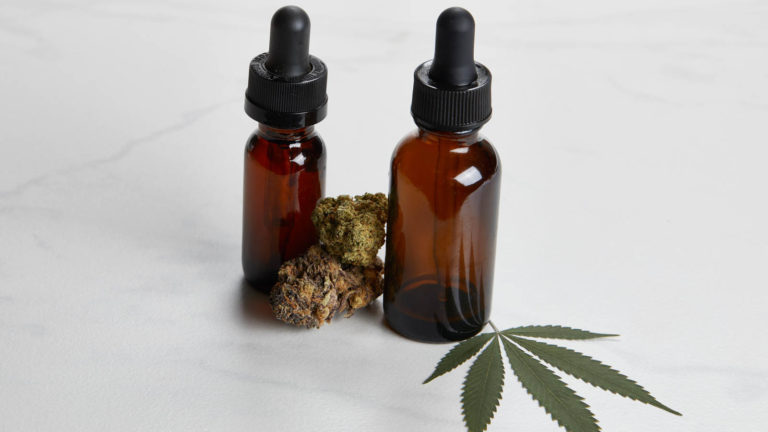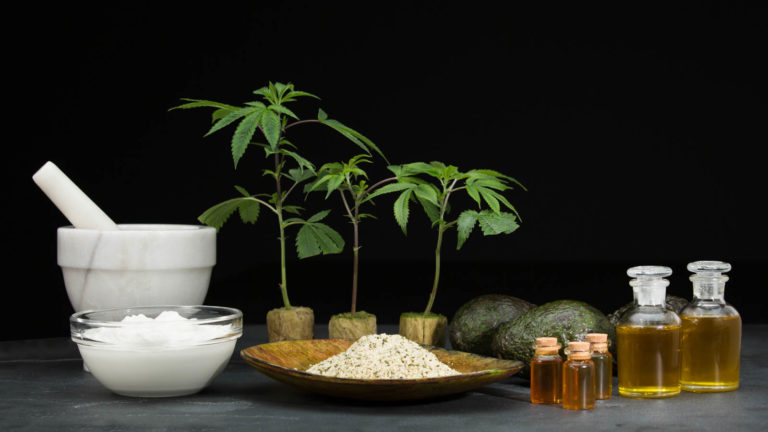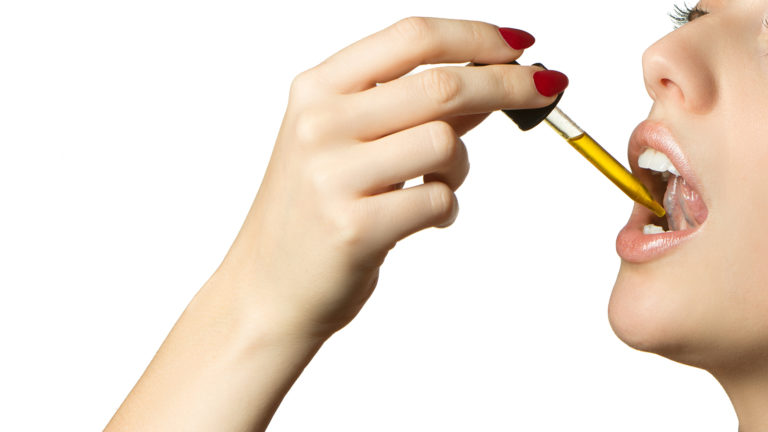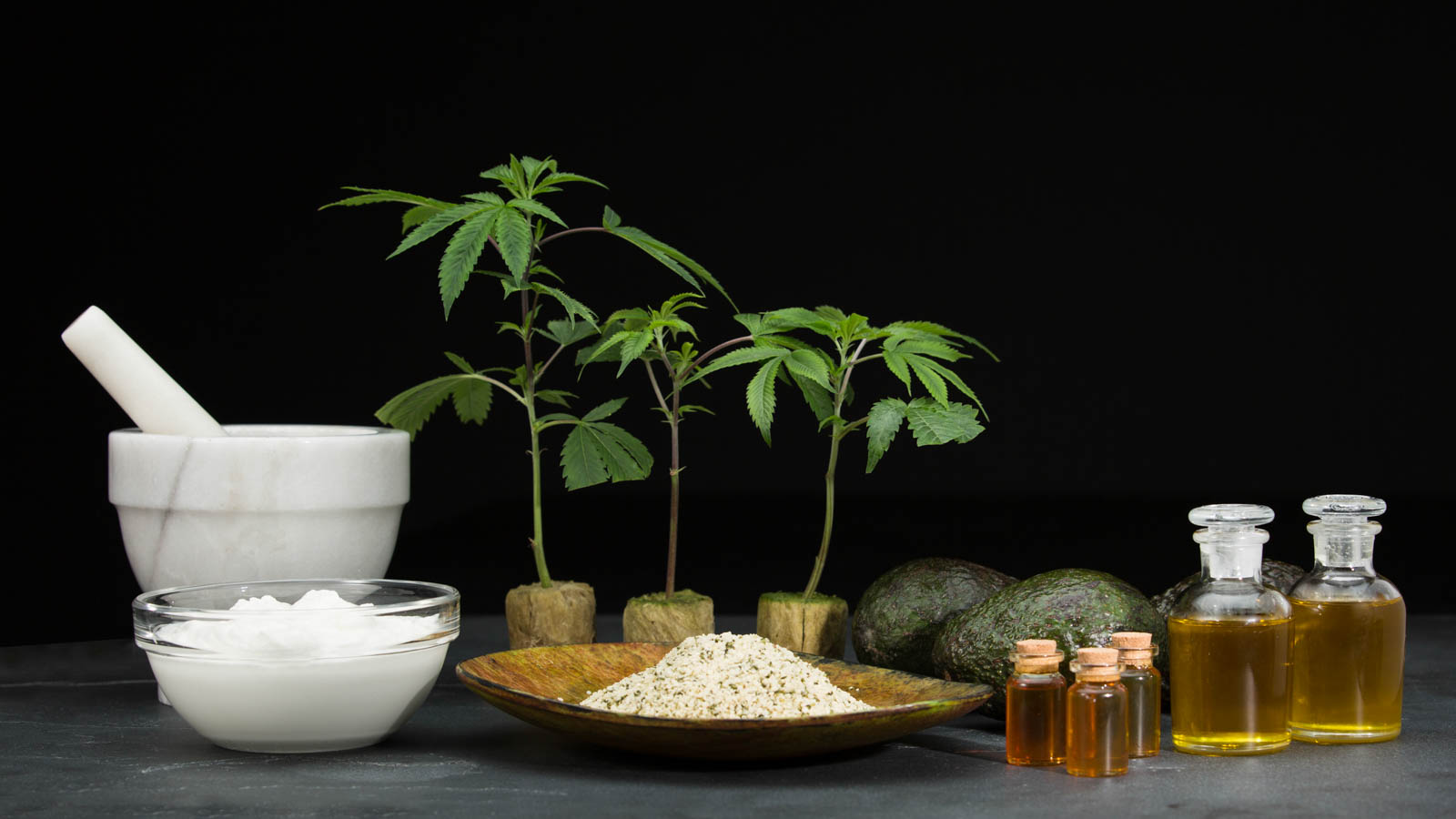What is CBD oil?
CBD oil is a refined hemp extract that has been added to a carrier oil. Hemp is a variety of cannabis that produces only trace amounts of tetrahydrocannabinol (THC), the cannabis component that can produce a psychoactive “high.” In fact, hemp is defined as having less than 0.3 % THC. Instead of producing THC, hemp plants contain mainly cannabidiol (CBD). Hemp has a long history of use for making fiber for textiles and rope, and has been bred to be tall and skinny with very small flowers, or buds.
 Photo by: Gina Coleman/Weedmaps
Photo by: Gina Coleman/WeedmapsImage lightbox

The explosive popularity of non-intoxicating cannabis products containing CBD has led to the development of a booming $1 billion industry. Those who seek CBD's medical benefits can consume a diversity of CBD-infused foods, supplements, and drinks. CBD oil has been used to treat wide-ranging symptoms, such as pain, anxiety, depression, and acne.
CBD additives come in many forms, but all fall into three major categories: CBD oil, CBD-rich cannabis oil, and CBD isolate. While “CBD oil” and “CBD-rich cannabis oil” may seem like two words for the same product, they differ significantly, mainly due to the fact that two distinct kinds of cannabis are used to make each.
History of CBD oil laws
The Marihuana Tax Act of 1937 made all cannabis varieties, including hemp, completely illegal, but the passage of the 2018 Farm Bill legalized the cultivation of hemp for fiber, while also legalizing the extraction of CBD from hemp if the hemp was grown in accordance with the law. This bill led to the rapid expansion of CBD products including oils, balms, creams, and gummies.. Interstate commerce of these products lies in a legal gray area because CBD and cannabis extracts are still considered a Schedule 1 narcotic, but the United States Drug Enforcement Agency has not enforced this regulation on businesses that sell CBD oil.
Making CBD oil
On a large scale, CBD oil is made by extracting entire hemp plants creating a crude paste, which is then refined in several ways and added to a carrier oil. Other minor cannabis components with some medical benefits, (such as cannabigerol (CBG), cannabichromene (CBC), and cannabidivarin (CBDV), are extracted alongside with CBD. Terpenes, the components responsible for the smell of cannabis and other flowers and plants, are sometimes reintroduced to harness additional medical benefits. Because CBD oil contains other components, it may be referred to as broad spectrum CBD oil, which reportedly has greater benefits than if CBD is taken on its own.
 Photo by: Gina Coleman/Weedmaps
Photo by: Gina Coleman/WeedmapsImage lightbox

Making CBD-rich cannabis oil
This type of CBD product generally refers to a cannabis extract high in CBD that has not necessarily been added to a carrier oil. Instead of using hemp plants, this product is produced using drug-type cannabis plants bred to make mostly CBD, and little THC. Drug-type cannabis differs from hemp in that it has been bred for generations to make large buds coated in THC-rich cannabis resin that are prime for smoking and making into edibles and topical salves. While drug-type cannabis typically produces high levels of THC, interest in the medical benefits of CBD has motivated people to breed high-CBD plants. High-CBD drug-type cannabis produces much more CBD per plant than hemp does, but because of their lineage, they are not legal to grow under the 2018 Farm Bill. These CBD plants are, however, legal to grow in certain states with medical and recreational cannabis laws, and cannabis extracts made using these plants may be purchased in those states.
Making CBD isolate
CBD isolate is, in short, pure CBD. Isolate is made by refining CBD oil or CBD-rich cannabis oil. Due to the low cost of growing hemp versus high-CBD drug-type plants, CBD oil is often a cheaper source than CBD-rich cannabis oil for the production of CBD isolate. CBD isolate is a white, slightly sticky powder.
 Photo by: Gina Coleman/Weedmaps
Photo by: Gina Coleman/WeedmapsImage lightbox

How to make CBD oil at home
To fully harness the medical benefits of CBD, customizing the consistency, potency, and carrier liquid of your of CBD oil for your needs is essential. The most straightforward and efficient way to make your own CBD oil is to start with CBD isolate, which is readily available in dispensaries and online from reputable sources. Another easy way to administer CBD oil is by dissolving it in alcohol, to make what is known as a tincture.
Tools for making CBD oil
Many of the tools needed for the home production of CBD oils or tinctures are likely to be things you already have in your kitchen or medicine cabinet. A jeweler's scale that can measure grams two places past the decimal point is a must to accurately measure your CBD isolate and can be purchased fairly cheaply online. A spoon or small scoop will be needed to transfer the measured CBD isolate to a storage container. Additionally, you will need either oil or alcohol. The exact type will be your preference, but some properties of each need to be considered before making a purchase. The simplest way to dose the CBD oil or tincture precisely is by using a dropper bottle that indicates how much it delivers; these typically measure out 1 milliliter for the whole dropper. Measuring the oil or alcohol is most easily done with an oral syringe.
Choosing an oil
As CBD isolate is neutral in taste, the oil in which it is dissolved will dictate the flavor of the final product. An unflavored oil, such as medium chain triglyceride oil, commonly known as MCT oil, will make for a neutral tasting product. Strong-tasting oils, such as coconut and olive, may be used as well if desired. Coconut oil is often solid at room temperature as it has a high content of saturated fat, so it will need to be heated carefully for making CBD oil. If you're making a tincture instead of an oil, a high grain alcohol is key. Liquor is diluted with water to an alcohol content of 40 -50 %, which is not suitable for dissolving CBD because of the high water content (CBD is not soluble in water). High-grain alcohol (90 % or greater) is needed for full incorporation.
 Photo by: Gina Coleman/Weedmaps
Photo by: Gina Coleman/WeedmapsImage lightbox

Dosing CBD oil
The first crucial step in the process of making CBD oil or tinctures is deciding the desired potency. Assuming you want to administer your oil or tincture with a dropper bottle, it is necessary to know milligrams of CBD delivered per milliliter of oil/tincture. Most dropper bottles hold 1 fluid ounce (1 fluid ounce ~ 30 milliliters). Dissolving 600 milligrams of CBD in 30 milliliters of liquid will make an oil/tincture that delivers 20 milligrams of CBD per milliliter (600 mg ÷ 30 mL = 20 mg/mL). To make a higher potency oil/tincture, dissolve more CBD in the same volume; the total milligrams of CBD you add, divided by the total volume of the oil/alcohol you add, will give you the potency in milligrams per milliliter (mg/mL).
 Photo by: Gina Coleman/Weedmaps
Photo by: Gina Coleman/WeedmapsImage lightbox

If you're using any oil except for coconut, weigh the desired amount of CBD isolate on a notecard on your scale. Fold one edge of the notecard, place the folded angle into the edge of the dropper bottle, and carefully tap the notecard until the CBD falls into the bottle (do this over a clean tray to gather anything that may have fallen during the process). Pour your measured amount of oil or alcohol into the dropper bottle (30 milliliters or 1 fluid ounce if you follow the guide above). Shake and swirl; the heat from your hand will help dissolve the CBD, but it may take a few minutes. The final product is shelf-stable and ready to administer orally, into topicals, or into foods and drinks.
Due to its higher saturated fat content, coconut oil is mostly solid at room temperature (unless you're in a very hot climate) and therefore cannot be administered with a dropper bottle. The coconut oil must be heated until liquid before dissolving the CBD. You can simply heat a measured amount of oil for your desired dose in a small pot or saucepan at a very low temperature. It is important to monitor the oil for signs of overheating and adjust the temperature accordingly. Alternatively, a double boiler can be used in place of a saucepan.
If you prefer to make a tincture but are concerned with the high alcohol content needed, glycerine can be used to dilute alcohol-based tinctures. CBD is not particularly soluble in glycerine on its own; however, CBD already dissolved in alcohol can be fully incorporated with glycerine to dilute or sweeten the tincture. Dosing will need to be adjusted with the addition of a larger volume of fluid. This can easily be done by making the initial tincture more potent and diluting it down with glycerine to your desired concentration.
Bottom line
You can channel the potential health benefits of CBD oil at home, but you should consult your physician before beginning a regimen and verify any applicable state or local laws.

